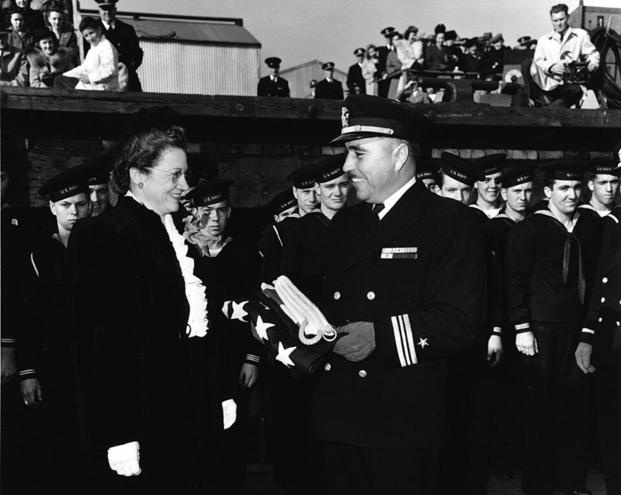At dawn on October 25, 1944, the U.S. Navy escort-carrier group “Taffy 3” sighted the Imperial Japanese Navy’s remaining battleship fleet approaching from the northern horizon off Samar—four battleships, six heavy cruisers, two light cruisers, and 11 destroyers led by Vice Adm. Takeo Kurita.
Taffy 3—consisting of six escort carriers, three destroyers, and four destroyer escorts—was there to cover troops storming the Philippine beaches, not to duel a surface fleet that included the Yamato, the largest battleship ever built. But there was no one else between Kurita and the invasion fleet in Leyte Gulf.
An American Destroyer at the Battle of Leyte Gulf
USS Johnston, a Fletcher-class destroyer under Cmdr. Ernest E. Evans reacted first. Only a year earlier, Evans had told his crew, “This is going to be a fighting ship. I intend to go in harm’s way, and anyone who doesn’t want to go along had better get off right now.”
He made good on that pledge at Samar. The Johnston maneuvered to lay down a smoke screen to cover the carriers, then turned toward the Japanese fleet. Evans ordered the ship at flank speed, closing to torpedo range while under heavy fire. She launched all ten torpedoes at the lead Japanese heavy cruiser Kumano. At least one struck home, blowing off Kumano’s bow and forcing her out of action while its sister ship Suzuya, broke off to escort the crippled cruiser.
The return fire was devastating. Shells smashed into the Johnston, disabling her radio and an engine while killing or wounding multiple sailors, but the destroyer re-entered the fight. Her 5-inch guns raked the heavy cruiser Chikuma and helped set up later air attacks that finished that ship; she also fired on battleship Kongō, forcing the larger ship to maneuver away.
Taffy 3’s Counterattack at Samar
Inspired by Evans’ charge, the rest of Taffy 3’s screens joined the counterattack. USS Hoel and USS Heermann, along with destroyer escort Samuel B. Roberts, made their own torpedo runs through overwhelming fire and shell splashes. Meanwhile, Avengers and Wildcats from the carriers came off the decks with whatever they could carry, including depth charges when the bombs and torpedoes were gone.
The stunning defense—smoke screens, aggressive destroyer attacks at close range, and constant air strikes—threw Kurita’s fleet into confusion. Ships were badly damaged, others fell out of formation or were ordered to cover crippled ships, while the tiny American destroyers wreaked havoc. Three Japanese heavy cruisers (Chikuma, Chōkai, Suzuya) were lost before the day was over.
The Johnston turned again and followed the other screens into the battle despite her extensive damage. The ship fought for hours, darting in and out of rain squalls, trading fire with ships many times her size. One torpedomen later recalled, “We got off all ten torpedoes, and they ran hot, straight, and normal!”
The mighty and feared Yamato bore its massive guns onto the tiny American ship, which it mistakenly identified as a cruiser. The Yamato fired an entire broadside of armor-piercing shells, designed to sink other heavy ships, which blasted right through the Johnston. One shell tore through the bridge, severely injuring Evans and killing most of his command staff.
By about 9:30 a.m., she had taken more than twenty hits; steering and power failed, and she was dead in the water under concentrated cruiser and destroyer fire. Survivors remembered the ship so riddled “they couldn’t patch holes fast enough to keep her afloat.”
Cmdr. Evans finally ordered abandon ship around 9:45 a.m. Johnston rolled and sank just after 10:00; only 141 of her 327 crewmembers survived, and Evans was among the missing. He was later posthumously awarded the Medal of Honor for his heroic charge and sacrifice at Samar.

The Wreck of the USS Johnston
The effects of Johnston’s charge are admirable. Her torpedo strikes crippled Kumano; sustained close gunnery harassed and damaged numerous heavy cruisers; aggressive runs by all three destroyers repeatedly forced Japanese capital ships to avoid torpedo wakes and give up gunfire solutions.
The chaos bought priceless minutes for the carriers to flee east, launch continuous air strikes, and steadily annihilate the attackers. The result—three heavy cruisers lost and a Japanese naval withdrawal—which preserved the beachhead and ensured victory in the Philippines.
The Japanese fleet was all but destroyed during the overarching Battle of Leyte Gulf, the largest naval battle in history. The Yamato was later sunk by American aircraft during the Okinawa Campaign, ending any last hope for a Japanese victory in the Pacific.

From 2019 to 2021, several submersible teams located and surveyed the main wreck of the Johnston at 6,456 meters below the surface. Her hull number, 557, was still visible after decades underwater. It was the deepest located shipwreck in history, until the Samuel B. Roberts was found nearby the following year at 6,895 meters.
Johnston’s fight off Samar remains one of the most courageous actions ever attempted at sea. A 2,700-ton destroyer and her crew charged against certain death against overwhelming power, managing to inflict severe damage on the enemy, and helped trigger a retreat that protected an entire invasion. Though she was lost during the battle, the tiny destroyer helped turn back the largest battleship ever built.
The ship and the men who sailed on her earned a Presidential Unit Citation and are remembered as the tiny American destroyer that took on Japan’s massive battleship fleet.
Story Continues
Read the full article here



